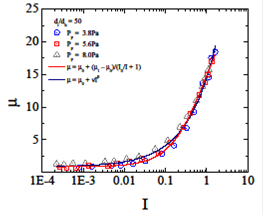Reports: ND954045-ND9: Particle Sedimentation in Clay Suspensions
Arshad A. Kudrolli, Clark University
We probed the dynamics of an intruder moving through sedimented particulate hydrogels immersed in water as a function of the properties of the intruder and the medium. This medium is used as a model for clay suspensions because it has similar rheological properties as clay including exhibiting a yield stress, and ageing. It enables a subtle examination of inertia, gravity, and viscosity on the intruder dynamics, as well as allowing visualization of the flow around the intruder because it is essentially transparent.
We first focused our study on the condition where the intruder moves with constant speed at constant depth. It must be noted that even under these conditions, the intruder motion leads to unsteady flow of the medium as it is fluidized and accelerated around the intruder. We found that the drag experienced by the intruder decreased with its speed but approached a constant value at low speed as can be expected in a medium which exhibits a yield stress. Further, by measuring the drag as a function of depth of the intruder, we found that the drag increased linearly with depth.
We obtained the inertial number I and the viscous number J to understand the relative importance of grain inertia and fluid viscosity on the observed dynamics. By measuring drag, we find that the effective friction given by the ratio of the average stress acting on the intruder and the overburden pressure can be parametrized by I, and not by J over the range of experimental parameters investigated. Further, we capture the overall form of the observed friction with a nonlinear increase with I from a value in the quasi-static limit which is independent of the depth of the intruder in the medium. We were also able to describe the overall form of the effective friction encountered by the intruder using the Herschel Bulkley model for visco-plastic medium.
Figure Caption: A comparison of the effective friction obtained as a function of the inertial number I is shown in the figure above. One notes the collapse of the data corresponding to intruder at different depth which leads to change in overburden pressure. The data is further compared with functional forms derived from Herschel Bulkley model of visco-plastic medium.
In complementary investigations, we then investigated the sedimentation dynamics of the intruder due to its weight in the medium. Thus, the constraint that the intruder at constant depth removed at the motion of the intruder was under constant applied force condition rather than under constant imposed strain rate. Taking advantage of the transparency of the medium, we measured the position of the intruder as a function of time. In this case, we found that the intruder came to rest at a depth which was proportional to its weight. Further, we then extracted in the effective friction experienced by the intruder. We find that the rheology as probed by the sedimenting intruder was also consistent with that for a Herschel Bulkley model with a friction coefficient which is constant with depth.
Thus, we have been able to forward a deeper understanding of rheology of non-buoyant granular medium immersed in water as well as quantitatively describe the unsteady motion of an intruder in such a medium.












